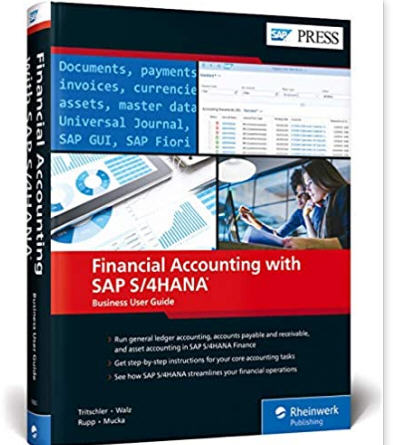Running accounting in SAP S/4HANA Finance?
This is your hands-on guide! Learn how financial accounting works with the Universal Journal and understand key organizational structures. Get step-by-step instructions to perform your finance tasks for the general ledger, accounts payable, accounts receivable, fixed assets, and customer projects and billing. With details on both classic SAP GUI transactions and modern SAP Fiori apps, as well as coverage of the new event-based revenue recognition, youíll find everything you need in these pages!
Perform your daily accounting tasks in SAP S/4HANA Finance:
- Follow step-by-step instructions to run general ledger accounting, accounts payable and receivable, asset accounting, and more.
- Explore customer project scenarios and use event-based revenue recognition.
Explore the processes that make up financial accounting: order to cash, purchase to pay, acquire to retire, and record to report. Understand the organizational structures and general ledger master data that provide the foundation for FI.
Tasks and Transactions
Walk through your core accounting activities, click by click. Post journal entries in the general ledger, create customer and vendor invoices, make payments, process bank statements, manage assets, set up customer projects, and more.
Period-End Close and Reporting
Close your books and report on your data. In each finance subarea, perform key tasks such as reconciliation, foreign currency valuation, and reclassifications. Learn about key transactions and apps available for reporting.
Key Topics Covered:
- General ledger accounting
- Accounts payable
- Accounts receivable
- Asset accounting
- Customer projects
- Event-based revenue recognition
- Organizational structure
- Period-end close
- Reporting
- SAP GUI transactions
- SAP Fiori applications
Introduction to SAP S/4HANA
Deployment Models
- On-Premise SAP S/4HANA
- SAP S/4HANA Cloud: Public and Private Edition
- Hybrid Models
- Single Source of Truth
- One Database and One Data Model for Accounting
- Enhanced Reporting
- Minimized Reconciliations
- Extension Ledger versus Special Ledger
- Simplified Period-End Close
- Management Accounting Integration
- Parallel Accounting and Currencies
- Predictive Accounting
- Event-Based Revenue Recognition
- SAP GUI
- Web GUI
- SAP Fiori
Standard Financial Accounting Processes
- Value Chain Overview
- Order-to-Cash and Accounts Receivable
- Purchase-to-Pay and Accounts Payable
- Acquire-to-Retire and Fixed Asset Accounting
- Record-to-Report and General Ledger
- Organizational Structures
- Cross-Application Organizational Assignments
- Central Financial Accounting Settings and Decisions
- Management Accounting Postings in the General Ledger
- Market Segment Reporting in the Universal Journal
- The Margin Analysis Application
- Intercompany Management Accounting Postings
Record-to-Report
- Subledger Closing
- Reconciliations
- Record and Adjust
- Period Control
- Reporting and Analysis
- Master Data Structure
- General Ledger Accounts
- Chart of Accounts
- Financial Statements
- Journal Document Entry
- Post, Park, and Hold
- Recurring Documents
- Post with References
- Post with Clearing
- Parallel Accounting
- Universal Parallel Accounting
Reversing Documents
- Reversing Non-Clearing Documents
- Reversing Clearing Documents
- Bank Master Data
- General Ledger Integration
- Bank Reconciliation
- Opening and Closing Periods
- Subledger Reconciliation
- Foreign Currency Valuation
- Goods Receipt/Invoice Receipt Clearing
- Balance Carryforward
- Financial Closing Cockpit
- Accounts Inquiry
- Trial Balance
- Display General Ledger Account Line Items
- Financial Statement
- Compact Document Journal
Purchase-to-Pay
- Purchase Requisition
- Purchase Order
- Goods Receipt
- Invoice Receipt
- Invoice Payment and Vendor Checking Balances
- Vendor General Data
- Vendor Company Code Data
- Automatic Creation of Vendor Invoices (from Logistics)
- Direct Invoices
- Manual Payment
- Automatic Payment Program
- Credit Memos
- Payments Sent
- Opening and Closing Periods
- Foreign Currency Valuation
- Goods Receipt/Invoice Receipt Clearing
- Automatic Open Item Clearing
- Reclassification Run
- Accounts Payable Reconciliations
- Accounts Inquiry
- Accounts Balance Report
- Open Item List
Order-to-Cash Process
- Sales Order
- Outbound Delivery
- Billing Documents
- Customer General Data
- Customer Company Code Data
- Automatic Creation of Customer Invoice (from Logistics)
- Direct Customer Invoices
- Manual Bank Statements
- Electronic Bank Statements
- Credit Memos
- Down Payments Received
- Automated Dunning Process
- Manual Dunning Letters
- Credit Master Data and Credit Limits
- Simple Credit Check
- Automated Credit Check
- Foreign Currency Valuation
- Billing Due Lists
- Reclassification Run
- Accounts Receivable Reconciliations
- Accounts Inquiry
- Account Balances Report
- Open Items List
- Aging List
Acquire-to-Retire Process
- Acquisition of Long-Lived Assets
- Capitalization/Activation
- Depreciation
- Retirement/Scrapping
- Asset Creation
- Asset Classes
- Account Determination
- Depreciation Key
- Depreciation Area
- Chart of Depreciation and Ledger Assignment
- Planning
- Actuals
- Master Data
- Acquisition/Integration to Vendor Invoice
- Standard Depreciation
- Impairment (Value Adjustment)
- Transfers
- Retirements/Disposals
- Fixed Assets History Sheet
- Acquisitions List
- Depreciation Lists
- Disposals
Customer Project Scenario in SAP S/4HANA Cloud
- Financial Accounting Innovations
- Simplified Customer Project Contract Setup
- Customer Project Setup Overview
- Customer Project Business Transactions
- Customer Project Period-End Close
- Fixed-Price and Periodic Service Contracts
- Financial Reporting Insights
- Principles of Event-Based Revenue Recognition
- Event-Based Revenue Recognition for Customer Projects
- IFRS 15 Capabilities
- Supported Management Accounting Features
- Revenue Recognition Apps
- Supported Business Scenarios
- Activation and Configuration
- Positioning and Availability in SAP S/4HANA
